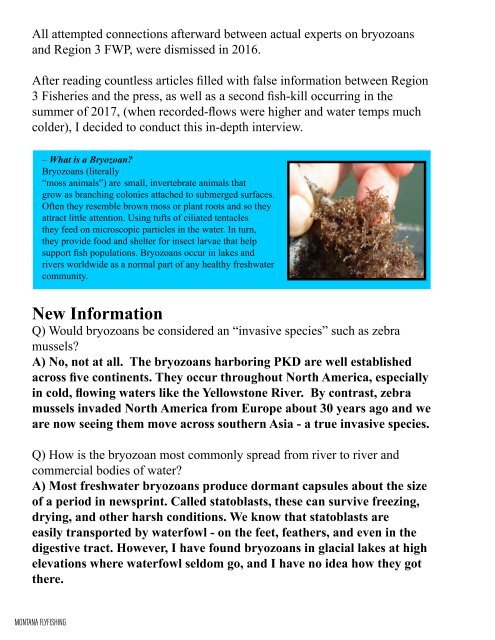Spring 2018
Montana Fly Fishing Magazine is the FREE digital magazine devoted to fly fishing in the great state of Montana.
Montana Fly Fishing Magazine is the FREE digital magazine devoted to fly fishing in the great state of Montana.
You also want an ePaper? Increase the reach of your titles
YUMPU automatically turns print PDFs into web optimized ePapers that Google loves.
All attempted connections afterward between actual experts on bryozoans<br />
and Region 3 FWP, were dismissed in 2016.<br />
After reading countless articles filled with false information between Region<br />
3 Fisheries and the press, as well as a second fish-kill occurring in the<br />
summer of 2017, (when recorded-flows were higher and water temps much<br />
colder), I decided to conduct this in-depth interview.<br />
– What is a Bryozoan?<br />
Bryozoans (literally<br />
“moss animals”) are small, invertebrate animals that<br />
grow as branching colonies attached to submerged surfaces.<br />
Often they resemble brown moss or plant roots and so they<br />
attract little attention. Using tufts of ciliated tentacles<br />
they feed on microscopic particles in the water. In turn,<br />
they provide food and shelter for insect larvae that help<br />
support fish populations. Bryozoans occur in lakes and<br />
rivers worldwide as a normal part of any healthy freshwater<br />
community.<br />
New Information<br />
Q) Would bryozoans be considered an “invasive species” such as zebra<br />
mussels?<br />
A) No, not at all. The bryozoans harboring PKD are well established<br />
across five continents. They occur throughout North America, especially<br />
in cold, flowing waters like the Yellowstone River. By contrast, zebra<br />
mussels invaded North America from Europe about 30 years ago and we<br />
are now seeing them move across southern Asia - a true invasive species.<br />
Q) How is the bryozoan most commonly spread from river to river and<br />
commercial bodies of water?<br />
A) Most freshwater bryozoans produce dormant capsules about the size<br />
of a period in newsprint. Called statoblasts, these can survive freezing,<br />
drying, and other harsh conditions. We know that statoblasts are<br />
easily transported by waterfowl - on the feet, feathers, and even in the<br />
digestive tract. However, I have found bryozoans in glacial lakes at high<br />
elevations where waterfowl seldom go, and I have no idea how they got<br />
there.<br />
MONTANA FLYFISHING




